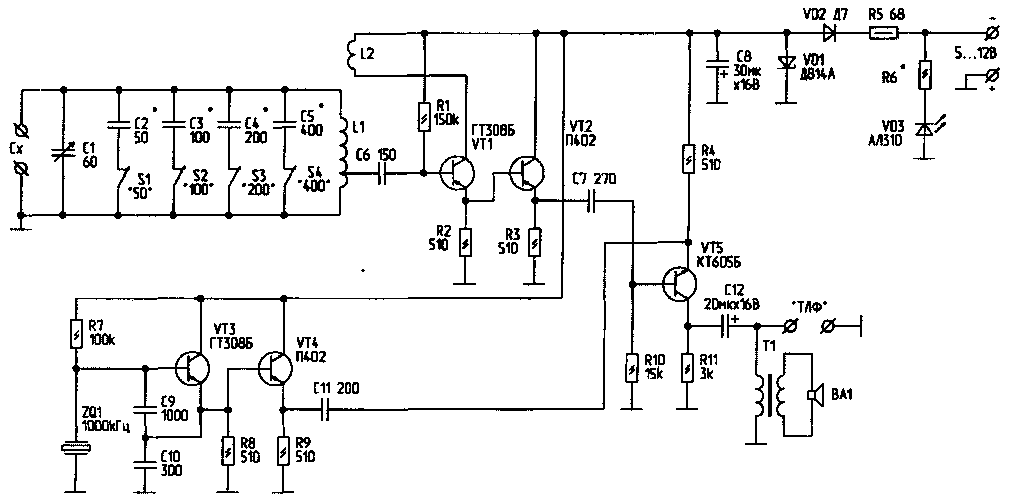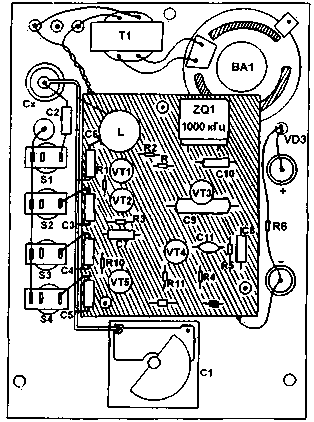
|
|
ENCYCLOPEDIA OF RADIO ELECTRONICS AND ELECTRICAL ENGINEERING The device for selection of capacities. Encyclopedia of radio electronics and electrical engineering
Encyclopedia of radio electronics and electrical engineering / Measuring technology When building HF and VHF equipment, radio amateurs often face the need for accurate selection of capacitors for smooth range generators, circuits, filters, etc. The proposed device allows not only to directly measure and compare the capacitances of capacitors with an accuracy of 0,5 pF, but also to determine the value and sign of TKE. The device measures the capacitance by the resonance method according to the equivalent circuit. The inclusion in the circuit of range capacitors C2 ... C5 (Fig. 1) in various combinations allows you to measure capacitances in the ranges 0 ... 50,50 ... 100,100 ... 150, 150 ... 200, 750 ... 800 pF. The device consumes a current of 30 mA when powered by a 12 V DC voltage source. Its dimensions are 120x200x70 mm. Weight - about a kilogram. The device is mounted in a metal box. On the front panel (Fig. 2) there is a handle with a sight fixed on the axis of the variable capacitor C1; a scale that is graduated in units of picofarads; switches S1 ... S4, which select the measurement range; clamps for connecting the subject "Сх"; jack for phone and power supply.
All installation is made on the back side of the front panel (Fig. 3).
The device circuit contains two generators with emitter followers and a mixer. One of the generators is a reference quartz, the second is parametric. When all range capacitors C2 ... C5 and the full capacitance of the variable capacitor C1 are connected to the parametric generator, the frequencies of the generators coincide, and zero beats are heard. On the scale, this corresponds to the mark "0". To obtain these beats in the initial state, the parametric generator must have a tuning element. This is best done with a brass tuning core in the L1 coil. Access to it is best done from the front panel. Before installing C1 in the device, using any factory capacitance meter, two marks are applied to the fixed plates of C1, the capacitance between which is 50 pF. After installing C1, a handle with a sight is attached to its axis. The sight is set opposite the risks "0" with the plates C1 fully inserted. After that, the movable plates are brought to another risk and the designation "50" is put. Now you can evenly divide the entire scale into fifty parts. Before setting up the device, it is necessary to select range capacitors C2 ... C5 with a minimum tolerance and alternately achieve the operation of the generators. After that, the tuning core L1 is set to the middle position, and when the device is turned on, zero beats are found by moving the pointer of the sight along the scale. If the frequency difference is insignificant (zero beats occur near the "0" mark), then the alignment of the sight with the zero of the scale is achieved by rotating the core L1, if significant - by changing the number of turns of the coil L1 or adding an additional capacitor to the circuit (when the frequency of the parametric generator is higher than required). To adjust C2 in the "50 pF" range, it is necessary to connect a variable capacitor to the "Cx" terminals at the initial zero beats, then move the sight to 50, and use the connected capacitor to set zero beats. After that, the capacitor of the device C1 is transferred to the "0" mark, and C2 is turned off. If C2 has the required capacitance, then zero beats are restored. If zero beats are not restored, and we, moving the sight, see that they arise when the sight is slightly deviated in one direction or another, then a small capacitor must be added to C2 or replaced with another one with a slightly lower capacitance. The selection of capacitors C3 ... C5 is carried out in a similar way. It is convenient to make "adjustable" capacitors of small capacity from two small pieces of wire of the PEV type, twisted together and located on the main capacitors. It must be borne in mind that due to the presence of a capacitance at the switches, when they are disconnected from the measuring circuit, the capacitance is not completely disconnected. The TKE sign of the tested capacitors is determined by the departure of zero beats after heating them with a soldering iron. The coil of the parametric generator L1 has a diameter of 18 mm, contains 50 turns of PEV wire 00,23 mm (winding - turn to turn) and an inductance of 27 ... 33 μH. The tap is made from the 15th turn, counting from the grounded end. L2 - 30 turns on a paper ring, winding height - 3 mm, wire diameter - 0,1 mm. The coupling coil is located on the side of the "hot" end of the coil L1. Switches S - toggle switches MT-1. Quartz ZQ1 (1 MHz) - in the B-1 case. The quartz leads are soldered directly into the circuit. It is desirable to use capacitors C2 ... C6, C9, C10 of the KSO type of the "G" group. C8, C12 - electrolytic for an operating voltage of 16 V, the rest of the capacitors are any small ones. Transformer and speaker BA1 - from any pocket receiver. Variable capacitor C1 - ceramic with a maximum capacitance of 60 ... 65 pF. LED VD3 - any (you only need to choose the resistance R6). Diode VD2 protects the device from failure in case of accidental power reversal. The parts of the device are mounted on a printed circuit board (surface mounting can also be used), which is fastened to the panel on racks with three screws (Fig. 3). Authors: S. Lebedev, L. Saveliev, Chita; Publication: N. Bolshakov, rf.atnn.ru
The world's tallest astronomical observatory opened
04.05.2024 Controlling objects using air currents
04.05.2024 Purebred dogs get sick no more often than purebred dogs
03.05.2024
▪ Seven-inch smartphone Samsung Galaxy J Max ▪ Touch laptops will become cheaper ▪ Adaptive phased antenna arrays ▪ What does a crack in plastic smell like?
▪ section of the site Calls and audio simulators. Article selection ▪ article by Molière. Famous aphorisms ▪ article What is a sticky shell? Detailed answer ▪ Aloe article. Legends, cultivation, methods of application ▪ article Resonance frequency meter. Encyclopedia of radio electronics and electrical engineering ▪ article Piezoceramic filters. Encyclopedia of radio electronics and electrical engineering
Home page | Library | Articles | Website map | Site Reviews www.diagram.com.ua |






 Arabic
Arabic Bengali
Bengali Chinese
Chinese English
English French
French German
German Hebrew
Hebrew Hindi
Hindi Italian
Italian Japanese
Japanese Korean
Korean Malay
Malay Polish
Polish Portuguese
Portuguese Spanish
Spanish Turkish
Turkish Ukrainian
Ukrainian Vietnamese
Vietnamese



 Leave your comment on this article:
Leave your comment on this article: